《DSP using MATLAB》Problem 8.36


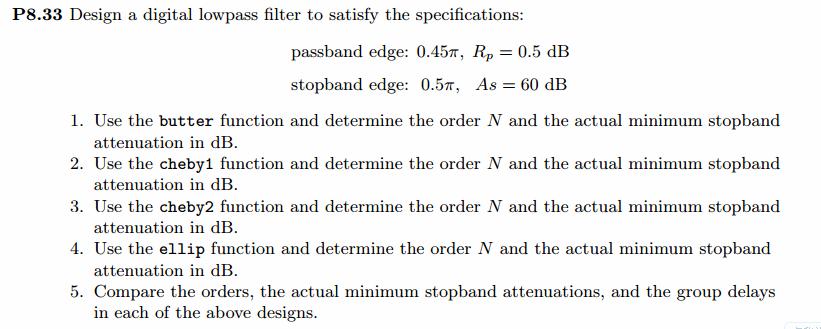
上代码:
function [wpLP, wsLP, alpha] = lp2lpfre(wplp, wslp)
% Band-edge frequency conversion from lowpass to lowpass digital filter
% -------------------------------------------------------------------------
% [wpLP, wsLP, alpha] = lp2lpfre(wplp, wslp)
% wpLP = passband edge for the lowpass digital prototype
% wsLP = stopband edge for the lowpass digital prototype
% alpha = lowpass to lowpass transformation parameter
% wplp = passband edge frequency for the given lowpass
% wslp = stopband edge frequency for the given lowpass
%
%
if wplp <= 0
error('Passband edge must be larger than 0.')
end if wslp <= wplp
error('Stopband edge must be larger then Passband edge')
end % Determine the digital lowpass cutoff frequencies:
wpLP = 0.2*pi;
alpha = sin((wpLP - wplp)/2)/sin((wpLP + wplp)/2);
wsLP = -angle((exp(-j*wslp)-alpha)/(1-alpha*exp(-j*wslp)));
function [b, a] = dlpfd_bl(type, wp, ws, Rp, As)
% IIR Lowpass Filter Design using bilinear transformation
% -----------------------------------------------------------------------
% [b, a] = dlpfd_bl(type, wp, ws, Rp, As);
% type = 'butter' or 'cheby1' or 'cheby2' or 'ellip'
% b = numerator polynomial coefficients of lowpass filter , Direct form
% a = denominator polynomial coefficients of lowpass filter, Direct form
% wp = Passband edge frequency in radians;
% ws = Stopband edge frequency in radians (wp < ws);
% Rp = Passband ripple in +dB; Rp > 0
% As = Stopband attenuation in +dB; As > 0
%
%
%prompt = 'Please input the type of digital lp filter: butter or cheby1 or cheby2 or ellip [butter] ';
%type = input(prompt , 's'); if isempty(type)
str = 'butter';
end switch type
case 'butter'
[b , a] = buttlpf(wp, ws, Rp, As);
case 'cheby1'
[b , a] = cheb1lpf(wp, ws, Rp, As);
case 'cheby2'
[b , a] = cheb2lpf(wp, ws, Rp, As);
case 'ellip'
[b , a] = eliplpf(wp, ws, Rp, As);
otherwise
disp('Oh, input may be error!');
end
第1小题
%% ------------------------------------------------------------------------
%% Output Info about this m-file
fprintf('\n***********************************************************\n');
fprintf(' <DSP using MATLAB> Problem 8.36.1 \n\n'); banner();
%% ------------------------------------------------------------------------ % Digital lowpass Filter Specifications:
wplp = 0.45*pi; % digital passband freq in rad
wslp = 0.50*pi; % digital stopband freq in rad
Rp = 0.5; % passband ripple in dB
As = 60; % stopband attenuation in dB Ripple = 10 ^ (-Rp/20) % passband ripple in absolute
Attn = 10 ^ (-As/20) % stopband attenuation in absolute fprintf('\n*******Digital lowpass, Coefficients of DIRECT-form***********\n');
[blp, alp] = buttlpf(wplp, wslp, Rp, As)
%[blp, alp] = cheb1lpf(wphp, wshp, Rp, As)
%[blp, alp] = cheb2lpf(wphp, wshp, Rp, As)
%[blp, alp] = eliplpf(wphp, wshp, Rp, As)
[C, B, A] = dir2cas(blp, alp) % Calculation of Frequency Response:
[dblp, maglp, phalp, grdlp, wwlp] = freqz_m(blp, alp);
%[dbhp, maghp, phahp, grdhp, wwhp] = freqz_m(bhp, ahp); % ---------------------------------------------------------------
% find Actual Passband Ripple and Min Stopband attenuation
% ---------------------------------------------------------------
delta_w = 2*pi/1000;
Rp_lp = -(min(dblp(1:1:ceil(wplp/delta_w)+1))); % Actual Passband Ripple fprintf('\nActual Passband Ripple is %.4f dB.\n', Rp_lp); As_lp = -round(max(dblp(ceil(wslp/delta_w)+1:1:501))); % Min Stopband attenuation
fprintf('\nMin Stopband attenuation is %.4f dB.\n\n', As_lp); %% -----------------------------------------------------------------
%% Plot
%% ----------------------------------------------------------------- figure('NumberTitle', 'off', 'Name', 'Problem 8.36.1 Butterworth lowpass by buttlpf function')
set(gcf,'Color','white');
M = 2; % Omega max subplot(2,2,1); plot(wwlp/pi, maglp); axis([0, M, 0, 1.2]); grid on;
xlabel('Digital frequency in \pi units'); ylabel('|H|'); title('Lowpass Filter Magnitude Response');
set(gca, 'XTickMode', 'manual', 'XTick', [0, 0.45, 0.5, M]);
set(gca, 'YTickMode', 'manual', 'YTick', [0, 0.9441, 1]); subplot(2,2,2); plot(wwlp/pi, dblp); axis([0, M, -150, 1]); grid on;
xlabel('Digital frequency in \pi units'); ylabel('Decibels'); title('Lowpass Filter Magnitude in dB');
set(gca, 'XTickMode', 'manual', 'XTick', [0, 0.45, 0.5, M]);
set(gca, 'YTickMode', 'manual', 'YTick', [ -111, -85, -1, 0]);
%set(gca,'YTickLabelMode','manual','YTickLabel',['111'; '85'; '1 ';' 0']); subplot(2,2,3); plot(wwlp/pi, phalp/pi); axis([0, M, -1.1, 1.1]); grid on;
xlabel('Digital frequency in \pi nuits'); ylabel('radians in \pi units'); title('Lowpass Filter Phase Response');
set(gca, 'XTickMode', 'manual', 'XTick', [0, 0.45, 0.5, M]);
set(gca, 'YTickMode', 'manual', 'YTick', [-1:1:1]); subplot(2,2,4); plot(wwlp/pi, grdlp); axis([0, M, 0, 20]); grid on;
xlabel('Digital frequency in \pi units'); ylabel('Samples'); title('Lowpass Filter Group Delay');
set(gca, 'XTickMode', 'manual', 'XTick', [0, 0.45, 0.5, M]);
set(gca, 'YTickMode', 'manual', 'YTick', [0:10:20]); % -----------------------------------------------------
% method 2
% -----------------------------------------------------
% Digital lowpass Filter Specifications:
[wpLP, wsLP, alpha] = lp2lpfre(wplp, wslp); prompt = '\nPlease input the type of digital lp filter: \n\n butter or cheby1 or cheby2 or ellip [butter]: ';
type = input(prompt , 's'); [blp, alp] = dlpfd_bl(type, wplp, wslp, Rp, As); [C, B, A] = dir2cas(blp, alp); % -----------------------------------------------------
% method 3 butter function
% -----------------------------------------------------
% Calculation of Butterworth lp filter parameters:
[N, wn] = buttord(wplp/pi, wslp/pi, Rp, As) % Digital Butterworth lowpass Filter Design:
[blp, alp] = butter(N, wn, 'low') [C, B, A] = dir2cas(blp, alp) % Calculation of Frequency Response:
[dblp, maglp, phalp, grdlp, wwlp] = freqz_m(blp, alp);
%[dbhp, maghp, phahp, grdhp, wwhp] = freqz_m(bhp, ahp); % ---------------------------------------------------------------
% find Actual Passband Ripple and Min Stopband attenuation
% ---------------------------------------------------------------
delta_w = 2*pi/1000;
Rp_lp = -(min(dblp(ceil(1:1:wplp/delta_w+1)))); % Actual Passband Ripple fprintf('\nActual Passband Ripple is %.4f dB.\n', Rp_lp); As_lp = -round(max(dblp(ceil(wslp/delta_w)+1 :1 : 501))); % Min Stopband attenuation
fprintf('\nMin Stopband attenuation is %.4f dB.\n\n', As_lp); %% -----------------------------------------------------------------
%% Plot
%% ----------------------------------------------------------------- figure('NumberTitle', 'off', 'Name', 'Problem 8.36.1 Butterworth lowpass by butter function')
set(gcf,'Color','white');
M = 1; % Omega max subplot(2,2,1); plot(wwlp/pi, maglp); axis([0, M, 0, 1.2]); grid on;
xlabel('Digital frequency in \pi units'); ylabel('|H|'); title('Lowpass Filter Magnitude Response');
set(gca, 'XTickMode', 'manual', 'XTick', [0, 0.45, 0.5, M]);
set(gca, 'YTickMode', 'manual', 'YTick', [0, 0.9441, 1]); subplot(2,2,2); plot(wwlp/pi, dblp); axis([0, M, -100, 2]); grid on;
xlabel('Digital frequency in \pi units'); ylabel('Decibels'); title('Lowpass Filter Magnitude in dB');
set(gca, 'XTickMode', 'manual', 'XTick', [0, 0.45, 0.5, M]);
set(gca, 'YTickMode', 'manual', 'YTick', [-70, -60, -1, 0]);
set(gca,'YTickLabelMode','manual','YTickLabel',['70'; '60';'1 ';' 0']); subplot(2,2,3); plot(wwlp/pi, phalp/pi); axis([0, M, -1.1, 1.1]); grid on;
xlabel('Digital frequency in \pi nuits'); ylabel('radians in \pi units'); title('Lowpass Filter Phase Response');
set(gca, 'XTickMode', 'manual', 'XTick', [0, 0.45, 0.5, M]);
set(gca, 'YTickMode', 'manual', 'YTick', [-1:1:1]); subplot(2,2,4); plot(wwlp/pi, grdlp); axis([0, M, 0, 90]); grid on;
xlabel('Digital frequency in \pi units'); ylabel('Samples'); title('Lowpass Filter Group Delay');
set(gca, 'XTickMode', 'manual', 'XTick', [0, 0.45, 0.5, M]);
set(gca, 'YTickMode', 'manual', 'YTick', [0:10:90]);
运行结果:
绝对指标
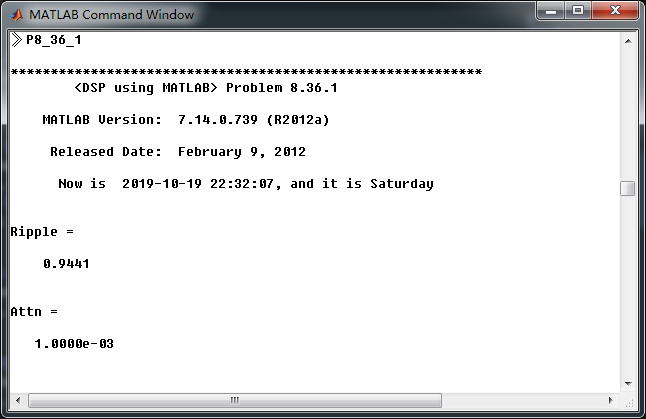
数字低通,频带边界截止频率

采用buttlpf函数,数字低通butterworth滤波器阶数51,系统函数直接形式系数
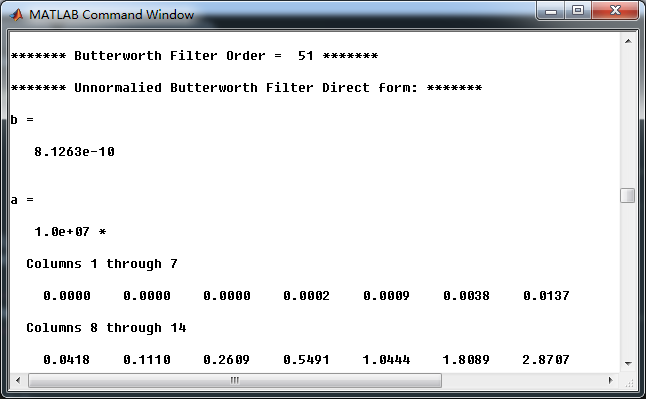
转换成串联形式,系数

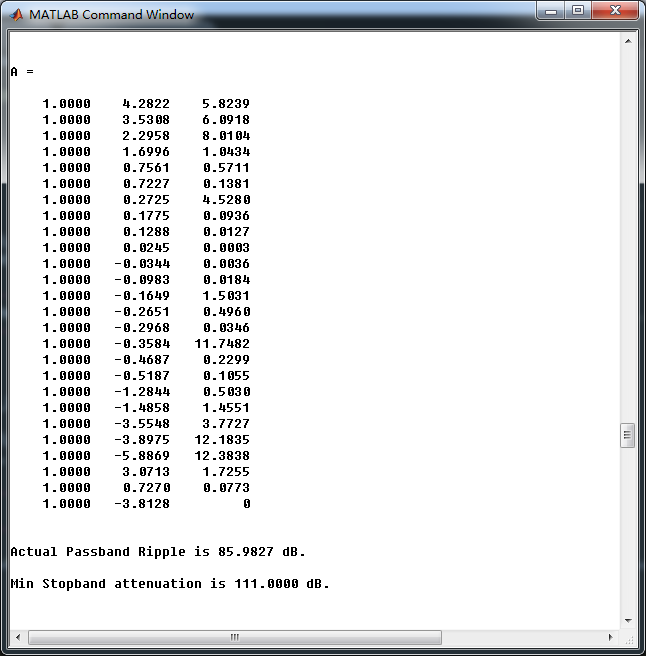
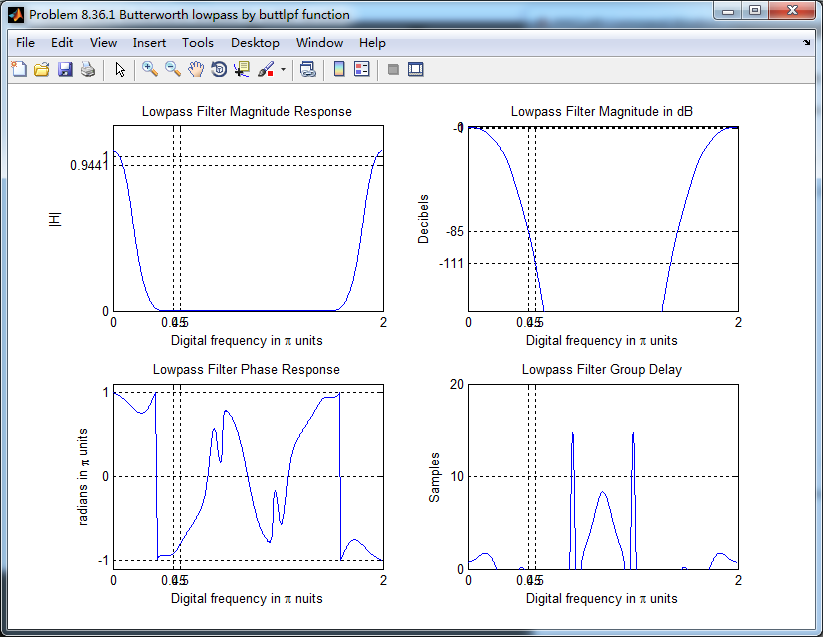

采用butter(MATLAB自带函数),计算数字低通滤波器,阶数51
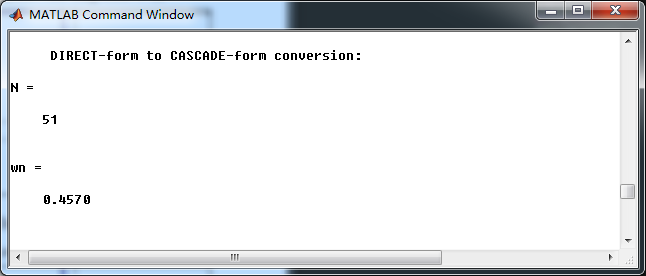
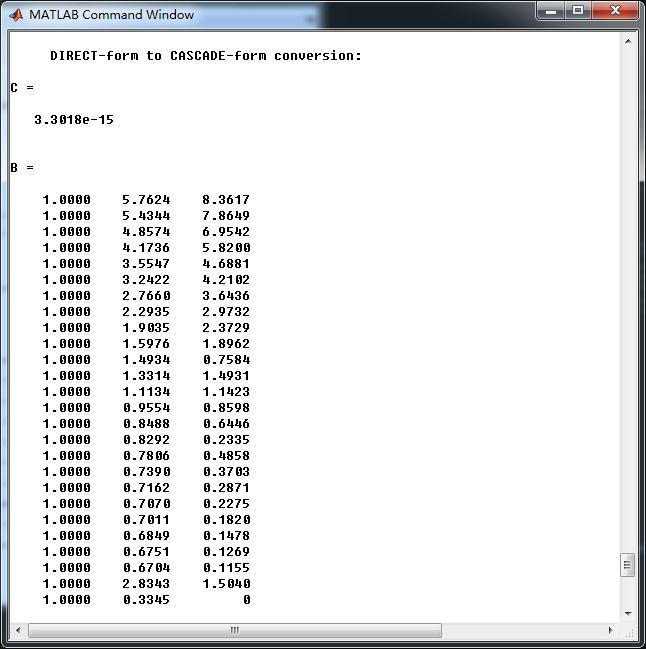

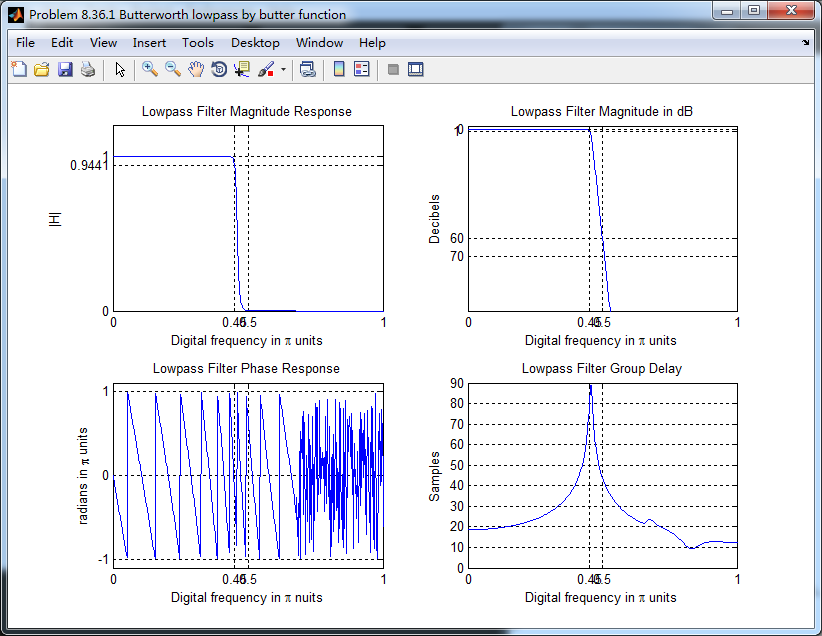
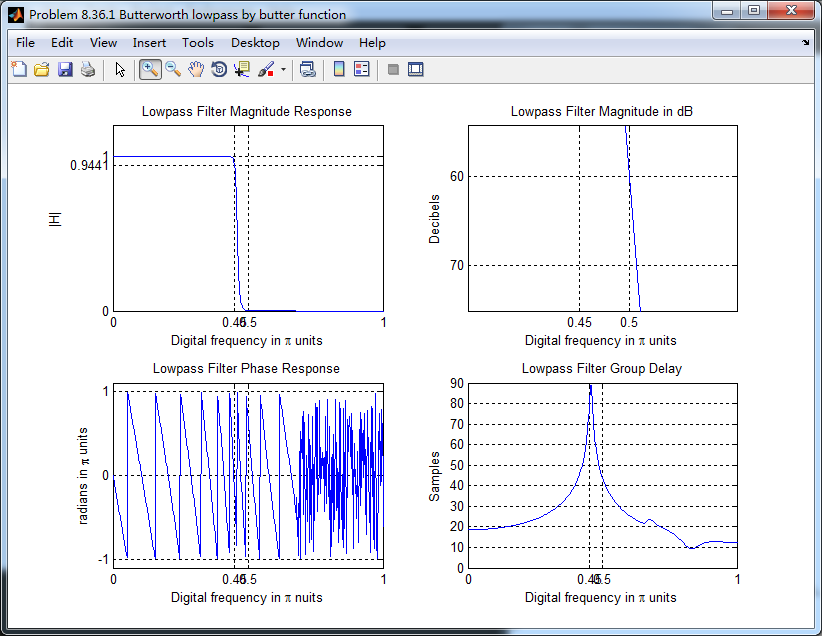
可见自带函数比个人所写的效果强!
第3小题,Chebyshev-2型
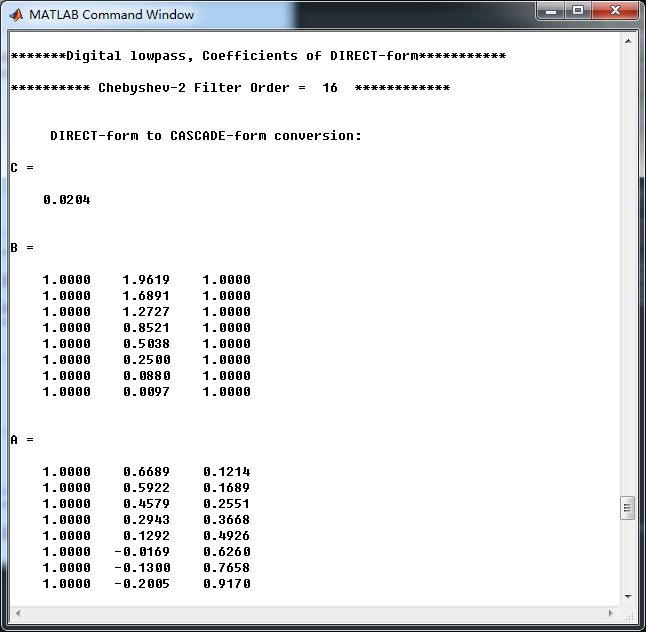
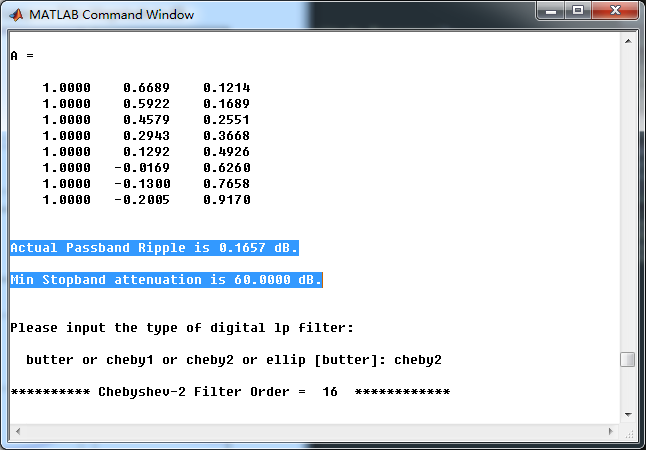
采用cheb2lpf函数,得到的Chebyshev-2型数字低通滤波器,幅度谱、相位谱和群延迟响应
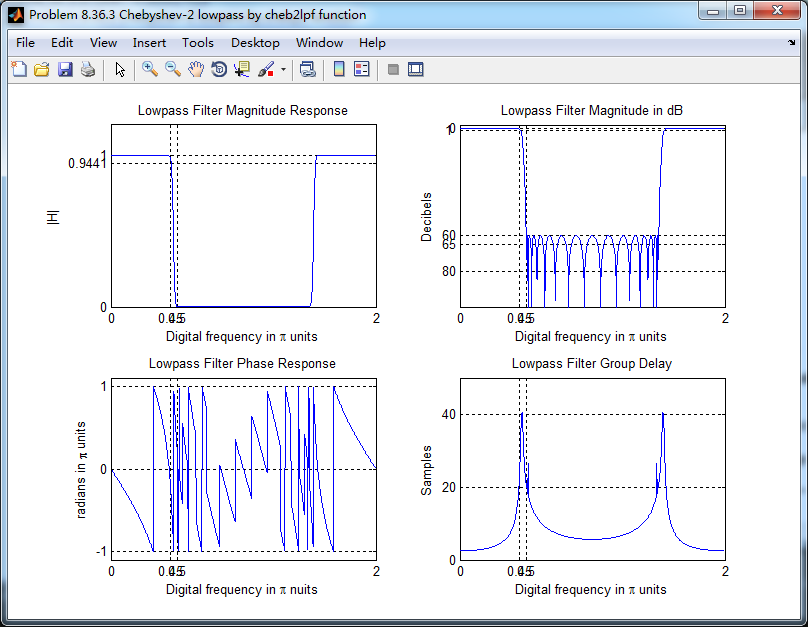
采用cheby2(MATLAB自带函数),计算得到数字低通滤波器,系统函数串联形式系数
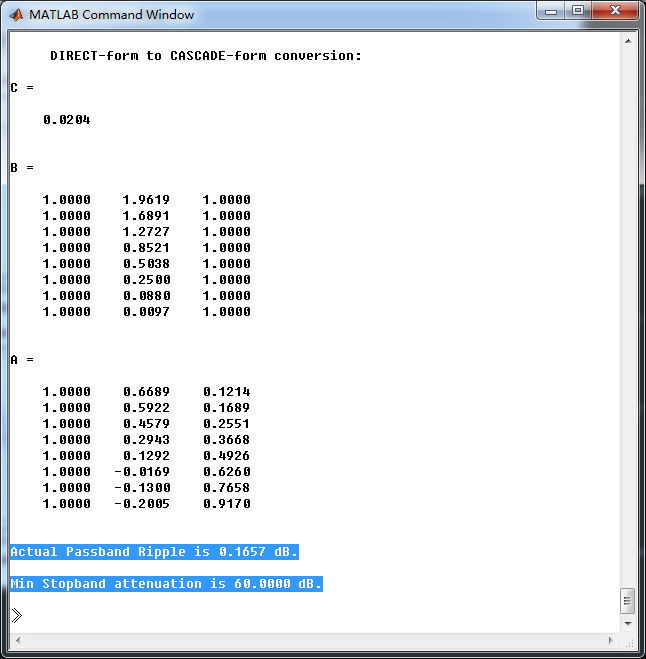
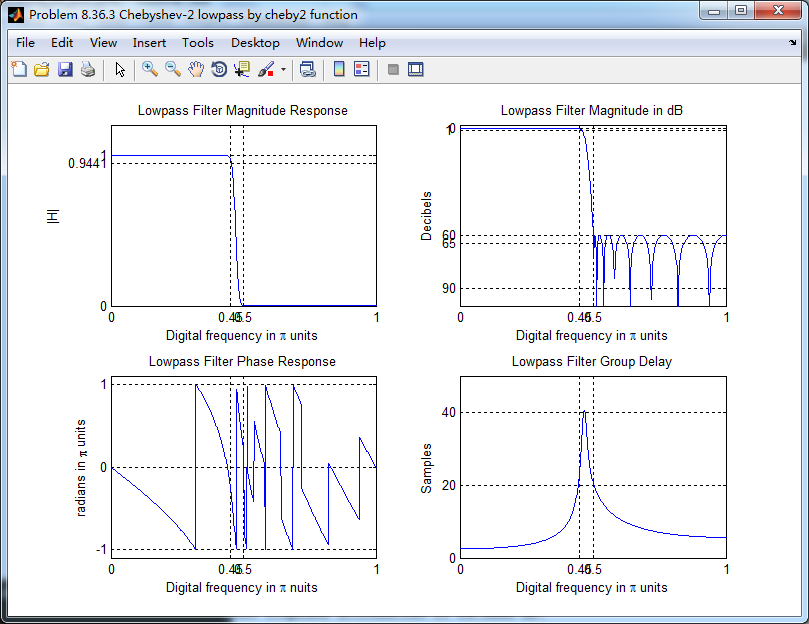
Chebyshev-1型和Elliptic型数字低通,这里不放图了。
《DSP using MATLAB》Problem 8.36的更多相关文章
- 《DSP using MATLAB》Problem 5.36
第1小题 代码: %% ++++++++++++++++++++++++++++++++++++++++++++++++++++++++++++++++++++++++++++++++++++++++ ...
- 《DSP using MATLAB》Problem 7.36
代码: %% ++++++++++++++++++++++++++++++++++++++++++++++++++++++++++++++++++++++++++++++++ %% Output In ...
- 《DSP using MATLAB》Problem 4.15
只会做前两个, 代码: %% ---------------------------------------------------------------------------- %% Outpu ...
- 《DSP using MATLAB》Problem 7.27
代码: %% ++++++++++++++++++++++++++++++++++++++++++++++++++++++++++++++++++++++++++++++++ %% Output In ...
- 《DSP using MATLAB》Problem 7.26
注意:高通的线性相位FIR滤波器,不能是第2类,所以其长度必须为奇数.这里取M=31,过渡带里采样值抄书上的. 代码: %% +++++++++++++++++++++++++++++++++++++ ...
- 《DSP using MATLAB》Problem 7.25
代码: %% ++++++++++++++++++++++++++++++++++++++++++++++++++++++++++++++++++++++++++++++++ %% Output In ...
- 《DSP using MATLAB》Problem 7.24
又到清明时节,…… 注意:带阻滤波器不能用第2类线性相位滤波器实现,我们采用第1类,长度为基数,选M=61 代码: %% +++++++++++++++++++++++++++++++++++++++ ...
- 《DSP using MATLAB》Problem 7.23
%% ++++++++++++++++++++++++++++++++++++++++++++++++++++++++++++++++++++++++++++++++ %% Output Info a ...
- 《DSP using MATLAB》Problem 7.16
使用一种固定窗函数法设计带通滤波器. 代码: %% ++++++++++++++++++++++++++++++++++++++++++++++++++++++++++++++++++++++++++ ...
随机推荐
- nacos注册中心配置命名服务不生效问题
nacos作为注册中心指定命名空间,配置如下: 但是启动之后发现服务都默认注册到了public这个命名空间下面,也就是指定的命名空间不生效 这是因为注册中心使用的命名空间的配置不是nacos.conf ...
- redis主从和集群搭建
主从搭建 redis的主从搭建非常简单,打开配置文件6379.conf,只需要将主节点的protected-mode设置为no,然后在从节点配置中加入:slaveof <masterip> ...
- 大数据学习路线,来qun里分享干货,
一.Linux lucene: 全文检索引擎的架构 solr: 基于lucene的全文搜索服务器,实现了可配置.可扩展并对查询性能进行了优化,并且提供了一个完善的功能管理界面. 推荐一个大数据学习群 ...
- $My$ $template$(持续更新)
树链剖分:(来源:树的统计) #include<bits/stdc++.h> #define rint register int using namespace std; inline v ...
- 取对数求阶乘位数——lightoj1045
/* 求 n! 在base进制下的位数 取对数,用换底公式,预处理对数前缀和 b^x = n! x = log_b(n!) = log_10(n!)/log_10(b) 对x向上取整即可 */ #in ...
- 阶乘质因子分解——lightoj1035
#include<bits/stdc++.h> using namespace std; #define ll long long #define maxn 200 int primes[ ...
- 40 VSCode下.json文件的编写——(1) linux/g++ (2).json中参数与预定义变量的意义解释
0 引言 转入linux/VSCode编程之后,迫切了解到有必有较为系统地学习一下VSCode中相关配置文件的写法.下面将分为 linux/g++编译指令..json文件关键词/替换变量的意义.编译链 ...
- NX-二次开发删除对象UF_OBJ_delete_object
NX9+VS2012 #include <uf.h> #include <uf_curve.h> #include <uf_obj.h> UF_initialize ...
- NX二次开发-UFUN获取块的参数UF_MODL_ask_block_parms
NX11+VS2013 #include <uf.h> #include <uf_modl.h> #include <uf_ui.h> UF_initialize( ...
- NX二次开发-UFUN编辑图层类别描述UF_LAYER_edit_category_descr
1 NX11+VS2013 2 3 #include <uf.h> 4 #include <uf_layer.h> 5 6 7 UF_initialize(); 8 9 //创 ...
